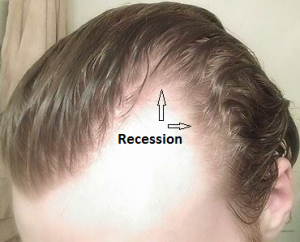The answer is no. In an analysis of 500,000 people in Europe (ref:new Scientist August 19th issue), people who were fat, controlled their blood pressure, cholesterol, blood sugar and exercised, still had a 26% increase in the risk of heart disease and heart attacks. The message is clear, being overweight can kill you!
What can I expect from a Class 6 pattern of balding?
The way this should be approached, is to analyse your hair with respect to its hair thickness (fine, medium or coarse, the coarser being better than fine hair), and the donor density. The number of grafts that can be safely moved in a Class 6 pattern of balding depends upon the donor density. The higher the donor density, the more grafts you have to move. A typical Caucasian male has ~110,000 hairs on their head with 50,000 Follicular units, or 2.2 hairs per cm square. There is a difference between FUE and Strip surgery maximum numbers as you can see in this chart: https://newhair.com/resources/#tab-id-4 so your doctor should measure your original donor density so that a plan for both the first transplant and the potential to cover the entire balding area with an additional transplant can be determined. A typical Caucasian with an average weight hair (thickness) can get reasonable coverage of a Class 6 balding pattern. Body hair is never as good, because the growth cycles are short and the length and thickness never matches the donor hair from the scalp in quality and length. If you don’t have enough hair, then Scalp Micropigmentation can make up the difference very nicely as shown in this article I wrote last year: https://newhair.com/wp-content/uploads/2018/11/Combining_Follicular_Unit_Extraction_and_Scalp.98621.pdf
Can you exercise enough to lose weight?
The answer to this question is NO. From the attached article here (Still No Giraffe) and a recent article in the Scientific American (June 2017), it is clear that our metabolic rate is relatively stable regardless of how much we exercise. The attached article has a scientist who followed a ‘primative bushman’ from Africa as he burned calories after he shot a giraffe with a poison dart and followed the giraffe for a few days on almost a constant run 12+ hours/day. He collected the bushman’s urine for the days he followed the giraffe. The bushman was fed a special type of water which was excreted in his urine indicating the calories he burned. He found out that the number of calories burned by this bushman was only about 10% above the calories burned by someone who sat at his desk all day. Our brains use the most calories we consume, following by our heart, our kidneys, out liver and our intestine. Our muscles are only responsible for about 10% of the calories we burn so if an average man burns 2680 calories per day and doubles his calorie burn from skeletal muscles (not really practical to do this), then he would bun only another 268 calories. That turned out to be a surprise for the researcher and the author who ran along side the bushman for a few days as he chased the giraffe. In the Scientific American this month (June 2017), another article focused on the number of calories burned by men or women and were shown to be relatively constant, regardless of the exercise program undertaken by either of them.
So you might ask, why exercise if you can’t lose weight? Why not just sit and watch TV all day and night? The answer is that exercise makes you healthier, lets you live longer and develop less diseases such as cancer, heart disease, stroke, diabetes and other diseases. The conclusion of both articles is that if you want to reduce weight, you must reduce your caloric intake. Sitting on a couch by the TV all day will just take all of what you eat (for example, eating just two small cookies per day can translate to a weight gain of one to three kilograms per year) all of which gets turned into fat. Of course, that is the problem in America today as 1/3rd of the population is obese (expected to be half of the US population by 2030) and about another 1/3rd may be overweight. Just like a car cruising at 50 miles per hour, if you overfeed it gasoline, it will overflow the tank (your body’s fat reserves here reflect that tank). There is no substitute for good eating and controlling your obsessive need to stuff foods into your mouth every-time you see a good ice cream cone or some extra BBQ ribs or a third hamburger with french fries until you feel stuffed. This type of obsessive eating increases your risk to dying with cancer, heart disease and stroke, especially if you don’t exercise. Add to that, Alzheimer’s disease, dementia and almost every disease we humans develop by being alive, and overeating leads us to an early grave.
Can Eyebrows Be Transplanted By Most Hair Transplant Surgeons?
I want my eyebrows transplanted. A new plastic surgeon just came to town and is offering eyebrow transplant. Should I trust him?
Eyebrow hair transplants are very difficult to perform. The hair grafts for the eyebrow must to placed flat against the upper bone of the eye socket. Unfortunately getting this done correctly, is not easily accomplished and should not be attempted except for the most experienced surgeons who have created many of these reconstructions with good results. I have seen the eyebrow hairs stick out forward as they were not placed flat or in the correct direction. Plucking them out work, but why should you have to pluck after having it done? Good question!
Restoring eyebrow hair is a rewarding endeavor, as this structure is so important to a person’s appearance, perhaps even more so than scalp hair. The secret to eyebrow transplantation (as in other types of hair restoration) is to closely observe nature. Unlike scalp hair, the eyebrows consist of only one-hair follicular units, so that if the source of hair is the larger follicular units obtained from the permanent zone in the back of the scalp, these units (of 2, 3, and 4-hairs) must be carefully split up into individual follicles under the microscope.
Replicating the unique directional changes of eyebrow hair is also critical to a successful restoration. The hair points upward in its medial aspect (near the nose) and then fans outwards as one moves towards the temples. However, the angles are not quite so simple. As one moves laterally (towards the temples), the hair in the upper half of the brow points to the side and down and the hair in the lower half points to the side and up. The upper and lower hairs interdigitate causing the central part of the eyebrow to slightly rise and form a gentle ridge which gives the eyebrow its unique shape. This interlocking also keeps the eyebrow hair orderly and “neat” in appearance. All of the eyebrow hair emerges from the skin at a very acute angle (almost flat), so the recipient sites must be made with the needle actually lying on the skin surface.
Just as the outer edge of the female hairline is often comprised of finer hair, so are the outer boarders of the eyebrows. In a sense, each eyebrow can be viewed as a cosmetic unit, just as the scalp, with transition zones of fine hair around much of the perimeter. As with the frontal hairline and temples, this fine hair may be replicated by removing or producing controlled, intentional damage to the bulb (cutting off part or all of the bottom) of a normal terminal follicle. The practice of using all fine hair for the eyebrows is incorrect since the eyebrows, like the scalp, require a central area of greater density, and bulk, and this is best accomplished with intact (but in this case individual) hair follicles. In all cases, multiple sessions are needed for a complete eyebrow restoration.
2015-01-14 07:13:142015-01-09 09:39:49Can Eyebrows Be Transplanted By Most Hair Transplant Surgeons?
Can finasteride accelerate hair loss
What Can I Expect to Happen One Month on Finasteride? (from Reddit)
Your story is pretty typical from what patients tell me. Many people don’t know that they have a decreased sex drive and some even report an increased sex drive.
2018-09-14 04:18:322018-09-14 09:47:01What Can I Expect to Happen One Month on Finasteride? (from Reddit)
Can Finasteride Cause Diabetes?
There is no known relationship with people taking finasteride and the appearance of diabetes. If you developed diabetes while on the drug, I suspect it is related to both your diet and heredity,
2018-08-06 06:32:032018-08-15 08:50:11Can Finasteride Cause Diabetes?
Am I receding? I am 24 years old and am very concerned
I have been seeing my hair go back every year since I was 17. I am scared that I will lose all of my hair. What can I do?
I would go on the drug Finasteride for a year and see if you can stop or reverse the loss. You have lost the frontal corner hairline as it is going up and the temple peaks are also gone. If this does not work, then a hair transplant would solve the problem very nicely.
2017-07-06 08:41:242017-06-21 15:26:39Am I receding? I am 24 years old and am very concerned
Can finasteride hold your hair forever? (from Reddit)
I have thousands of patients on finasteride and it is clearly holding on to their hair. When and if they stop it, the lose huge amounts of hair and then we have quite a conversation. Most want to get back on finasteride but some don’t fully go back to their hair status from before they stopped it. I have seen this effect in young men in there 20 and 30s and in men in their 60s and 70s as well.
2018-12-12 05:21:412018-12-11 15:21:57Can finasteride hold your hair forever? (from Reddit)
Can Finasteride Cause Thyroid Problems?
No, finasteride can not cause thyroid problems.
2019-01-31 05:08:412019-02-20 07:03:31Can Finasteride Cause Thyroid Problems?


